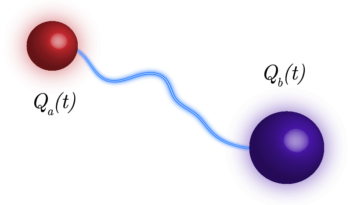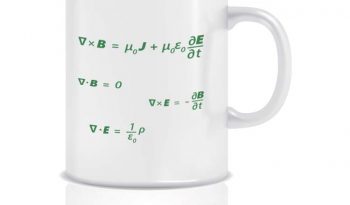When I was a student, I remember they taught me that the method of images to solve the problem of finding the electrostatic potential outside a grounded conducting sphere in the presence of an external point charge is a kind of miracle. Indeed, the fact that the method works seems like a miracle in the sense that you just have to write the potential corresponding to the original charge plus its image, then require it to be zero at two suitable points on the sphere to find the magnitude and location of the image charge, and miraculously the potential results zero at the infinitude of points on the sphere. To better illustrate my words, I quote here from the book “Introduction of Electrodynamics” by David J. Griffiths (Third edition p.125) the following paragraph the author wrote after illustrating the solution to the problem:
This solution is delightfully simple, but extraordinarily lucky. There’s much art as science in the method of images, for you must somehow think up the right “auxiliary problem” to look at. The first person who solved the problem this way cannot have known in advance what image charge \(q’\) to use or where to put it. Presumably, he (she?) started with an arbitrary charge at an arbitrary point inside the sphere, calculated the potential on the sphere, and then discovered that with \(q’\) and \(b\) just right the potential on the sphere vanishes. But it is really a miracle that any choice does the job…
I confess that I never liked “tricks” or “miraculous” solutions to problems in science in general and certainly no in physics in particular. I accept the observation that known facts can be used as auxiliary tools to solve other, sometimes difficult, problems. But many times a “miracle” can have an explanation. In the present article, I will show that there is nothing “lucky” or “fortunate” in the method of images. You will understand why the method works just for two cases\(^*\), namely: A grounded infinity plane and a grounded sphere. Everything follows naturally from the simple investigation of equipotential surfaces of a given configuration of charges.
\(^*\) There are more cases where the method can be used. All of them are based on the two cases mentioned here together with the property of superposition of the potentials due to several sources.
The equipotential surfaces of two point charges
Consider two electric point charges \(q\) and \(Q\) located at \((0,0,h)\) and \((0,0,H)\) respectively, with \(H\neq h\). There is no loss of generality in locating the charges along the \(z\) axis. After all, we are free to select the \(z\) axis to coincide with the straight line that pass through the two charges. The electric potential due to these charges is just
\begin{equation}
\phi(x,y,z)=k\left(\frac{q}{\sqrt{x^2+y^2+(z-h)^2}}+\frac{Q}{\sqrt{x^2+y^2+(z-H)^2}}\right)
\end{equation}
An equipotential surface is just the set of points \((x,y,z)\) such that the potential function \(\phi\) takes a constant value \(c\), i.e. an equipotential surface is described by the equation \(\phi(x,y,z)=c\). Let’s see what are the possible equi-potential surfaces corresponding to zero electric potential, i.e. \(\phi(x,y,z)=0\):
\begin{equation}
k\left(\frac{q}{\sqrt{x^2+y^2+(z-h)^2}}+\frac{Q}{\sqrt{x^2+y^2+(z-H)^2}}\right)=0
\end{equation}
We see that the charges \(q\) and \(Q\) necessarily have opposite sign. Otherwise Equation (2) can never be satisfied. We can rearrange the latter equation in the form
\begin{equation}
q\sqrt{x^2+y^2+(z-H)^2}=-Q\sqrt{x^2+y^2+(z-h)^2}
\end{equation}
After squaring both sides and rearranging terms we arrive to
\begin{equation}
(q^2-Q^2)\left(x^2+y^2+z^2\right)+2\left(Q^2h-q^2H\right)z+\left(q^2H^2-Q^2h^2\right)=0.
\end{equation}
There are two possibilities for the charges, namely: Either \(Q=-q\), or \(|Q|\neq |q|\). Let’s see what the equipotential surfaces are in each case.
Infinite plane at zero potential
Let’s consider the case when \(Q=-q\). We see that then \(q^2-Q^2=0\) and Equation (4) reduces to
\begin{equation}
2q^2\left(h-H\right)z+q^2\left(H^2-h^2\right)=0.
\end{equation}
The latter equation indicates that there is one possible value for \(z\), while \(x\) and \(y\) are unrestricted. We can solve Equation (5) for \(z\) to get
\begin{equation}
z=\frac{h+H}{2}.
\end{equation}
This is just the middle point between the location of the two charges. We clearly see that there is just one equipotential surface \(\phi(x,y,z)=0\) and that it is a plane that passes through the middle point between the charges.
We, of course, can obtain that result directly from the simple observation that all the points on the plane are at the same distance from both charges. But here we see that there is no chance for another possible configuration. Indeed, the charges are either of equal magnitude and opposite sign or have different magnitude and opposite sign. In the present case, the charges have equal magnitude, then the only possible equipotential surface with zero potential is the plane passing through the middle point between the charges and orthogonal to the segment that connects them.
We see that the potential \(\phi\) given by Equation (1) with \(Q=-q\) can be used to describe the potential in the region on one of the sides of the plane which is held at zero potential, and with just one point charge at some distance of it. I know that this point is somewhat confusing for the students. They very often ask why we are interested in the region on just one side of the plane when Equation (1) gives us the potential everywhere (except on the location of the point charges, of course). Let’s clarify this by explaining the original problem.
In the original problem, we have an infinite plane held at zero potential by grounding it, and a point charge \(q\) at a certain distance of the plane. The question is what is the potential everywhere. The answer has two parts. On the side of the plane where there is no point charge, the potential is just zero. To complete the answer, we need to determine the potential on the side where the point charge is located. In that region, the potential has to satisfy the Laplace\(^{**}\) equation \(\nabla^2\phi=0\), it has to take the value zero on the plane (that is a boundary condition), and in addition, it has to behave correctly near the point charge. By behaving correctly I mean that the expression for the potential near the point charge has to be essentially the potential of the point charge. It turns out that the potential given by Equation (1), satisfies all these conditions, so it is one solution to that part of the problem. But there is a theorem that ensures that the Laplace equation with the potential specified on the boundary, has a unique solution. So Equation (1) is not just one solution but the only solution. This means that the complete solution to the problem is zero on one side of the plane and Equation (1) on the other side. In this context, the “trick” to obtain the solution was to symmetrically locate a fictitious opposite charge to get the correct condition of vanishing potential on the midplane. Such a fictitious charge is called the image of the original one. From here the method bears its name.
Here I agree that in the traditional way the problem is solved, there is no miracle (nobody claimed that), and is very clear why the method works. But when talking about the grounded sphere problem, things are different.
\(^{**}\) Actually, what we have to solve in the region that contains the charge is the Poisson equation \(\nabla^2\phi(\vec{r})=-4\pi q\delta(\vec{r}-\vec{r}^{\ \prime})\) where \(\vec{r}^{\ \prime}\) is the location of the charge \(q\). and \(\delta(\vec{r}-\vec{r}^{\ \prime})\) is the delta function. This makes unnecessary the observation that the potential has to behave correctly near the point charge at the cost of having to explain the properties of the delta function.
The sphere at zero potential
The second possibility is that the magnitude of the charges is different, i.e. \(|Q|\neq |q|\). The charges still have to have opposite signs. In this case, \(q^2-Q^2\neq0\) and we can rewrite Equation (4) in the form
\begin{equation}
x^2+y^2+z^2+2\left(\frac{Q^2h-q^2H}{q^2-Q^2}\right)z=\frac{Q^2h^2-q^2H^2}{q^2-Q^2}.
\end{equation}
The latter equation corresponds to a sphere whose center is displaced from the origin of coordinates an amount \(z_0=(Q^2h-q^2H)/(q^2-Q^2)\) along the \(z\) axis. The radius \(R\) of the sphere can be easily calculated but its expression is not so illuminating so I leave its calculation to the reader. The location of the center, as well as the radius of the sphere, are determined by the four parameters \(q, Q, h, H\). We can look at this situation as if we have six parameters \(q, Q, h, H, R, z_0, \) and two independent relations between them, namely: The equations that determine \(z_0\) and \(R\). So we can fix four out of the six and calculate the remaining two.
Having made the preceding observation, let’s fix the radius \(R\) and the center of the sphere at the origin of coordinates, i.e. let’s fix \(z_0=0\). Thus, the coefficient of \(z\) in Equation (7) has to vanish, leading us to the relation \(Q^2h-q^2H=0\), or equivalently, and remembering that the charges have to have opposite signs, \(Q=-q\sqrt{H/h}\). This simplifies equation (7) to the form
\begin{equation}
x^2+y^2+z^2=\frac{Q^2h^2-q^2H^2}{q^2-Q^2}.
\end{equation}
Now the left hand of Equation (8) is just the square of the radius, i.e. \(R^2=(Q^2h^2-q^2H^2)/(q^2-Q^2)\). If we use the expression for \(Q\) in the latter one, we get the simpler relation \(R^2=hH\). The radius of the sphere is the geometric mean, i.e. \(R=\sqrt{hH}\) of \(h\) and \(H\), so that \(\text{min}\{h,H\}<R<\text{max}\{h,H\}\). This implies that the sphere necessarily encloses one of the charges only. Summarizing, we got the following relations:
\begin{equation}
R^2=hH\ \ ;\ \ Q=-q\sqrt{\frac{H}{h}}.
\end{equation}
Let me emphasize that what we obtained are natural relations between parameters that follow from looking at the zero equipotential surface corresponding to two point charges. Note that the spherical form arises naturally due to the fact that the potential of point charges are of the form \(1/r\), and the equation that defines the sphere is of the form \(r=R\). Look at Equation (4), and see that whenever the charges have different magnitude, the only possible zero equipotential surface, is necessarily a sphere.
This result solves the problem of finding the electrostatic potential due to a spherical conducting shell held at zero potential by grounding it, in the presence of one point charge. The electrostatic potential is given by Equation (1). One of the charges and its location are given from the start. The remnant charge and its location can be considered just as parameters determined by the relations given in Equation (9).
The method of images for the grounded conducting sphere
The problem consists of determining the electrostatic potential \(\phi\) when there is a grounded sphere of radius \(R\) (whose center is at the origin of coordinates), in the presence of a point charge \(q\) located at a distance \(h\) of the center of the sphere.
There are two cases. One case is when the point charge is outside the sphere, and the other one when it is inside. In any case, we want the potential in the region that contains the point charge \(q\) (In the region where there is no charge the potential is trivially zero). The solution is obtained by observing two things. The first thing is that Equation (1) solves the Laplace equation\(^{***}\) \(\nabla^2\phi=0\)(in both cases) and satisfies the condition of vanishing at the surface of the sphere whenever the parameters \(Q\), and \(H\) are related to the radius \(R\), the charge \(q\) and its location \(h\), through Equation (9). One of the charges and its location are given from start. The second charge is then considered to be the image of the given one. The second thing to observe is that there is a theorem that ensures that the Laplace equation with the potential specified at the boundary has a unique solution. So, that’s it. We got the solution namely: Equation (1) with \(Q\) and \(H\) given by Equation (9).
As you see, there is nothing miraculous in the solution. It just exploits the existence of equipotential surfaces for any distribution of charges.
\(^{***}\)See the footnote in the paragraph about the infinite grounded conducting plane. It also applies here.



Pingback: The electric field of a point charge surrounded by a thick spherical shell - Making Physics Clear